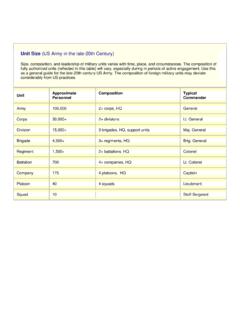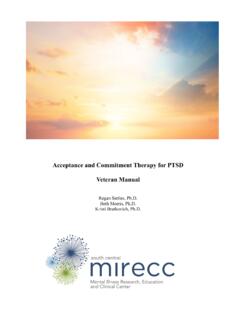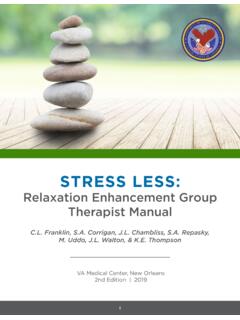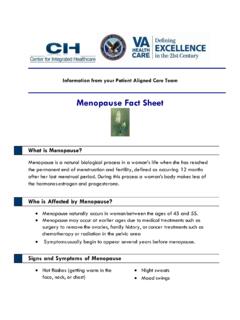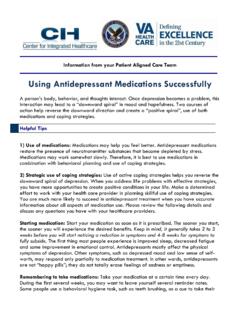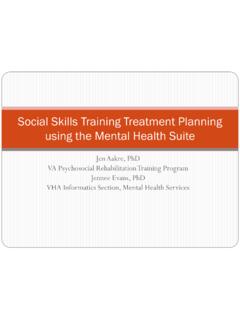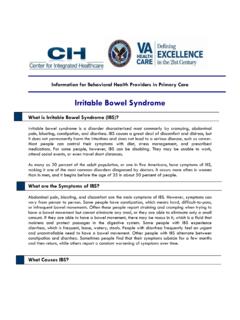Transcription of WHAT IS GENERALIZED ANXIETY DISORDER?
1 what ISGENERALIZED ANXIETY DISORDER? Mental Illness Research, Education and Clinical CenterVA Desert Pacific Healthcare NetworkLong Beach VA Healthcare SystemEducation and Dissemination Unit 06/116A5901 E. 7th Street | Long Beach, CA 90822 BASIC FACTS SYMPTOMS FAMILIES TREATMENTS2basic factsCourse of IllnessAlthough the median age of onset of GAD is age 30, many people develop the disorder as early as adolescence and as late as middle age (or even older). Many people have symptoms of GAD throughout their lives and many report being anxious and a wor-rier for as long as they can remember. GAD tends to be chronic, with symptoms that wax and wane across a lifetime. It is the most common ANXIETY disorder seen in older adults. Most people with GAD also have at least one co-occurring disorder, usually another ANXIETY disorder or a mood disorder, like are several factors that contribute to the development of GAD, including a family history of GAD or other ANXIETY or mood disorders , biological factors, personality and psychological factors, stressful life events, and environmental stressors.
2 Although much is unknown about the role of genes in the de-velopment of GAD, genetics research indicates that multiple genes are likely involved. Approximately one third of the risk of devel-oping GAD is due to genetic factors. These factors tend to overlap with other ANXIETY disorders and major depressive disorder, so if someone in a family has GAD, there is a good chance that someone else in their family will have GAD and/or another ANXIETY disor-der or depression. In addition to genes, other risk factors need to be present for someone to develop GAD. For example, many scientists believe that there is a biological contribution to the development and maintenance of GAD, such as an imbalance in brain chemicals, specifically GABA, serotonin, and norepinephrine. Personality style and psychological risk factors may also con-tribute to the development of GAD.
3 For example, a personality trait called neuroticism (the tendency to experience high levels of negative emotions, such as irritability, stress, and sadness), is a considered a risk factor for GAD. Another risk factor is called be-havioral inhibition, in which a person tends to be very fearful and what IS GENERALIZED ANXIETY DISORDER? - MIRECC - SPRING 2019 GENERALIZED ANXIETY disorder (GAD) is a psychiatric disor-der that is characterized by uncontrollable worry and ANXIETY . Al-though it is common for most people to experience some ANXIETY and worry from time to time, the symptoms are much more severe for those with GAD. Further, they experience physical symptoms associated with their ANXIETY , such as sleep difficulties, muscle ten-sion, and feelings of restlessness. People with GAD worry on most days and have difficulties controlling it. There are a variety of topics that people with GAD might worry too much about, for example, the health of themselves or loved ones, job or school- related issues, and finances.
4 They might also worry about minor things, like being on time or getting errands or household chores done. Some people with GAD also worry excessively about world- related issues, such as environmental problems or natural or man-made disasters. Most people with GAD also experience another ANXIETY disorder and/or a mood disorder ( , major depression).Prevalence Approximately of people will have a diagnosis of GAD at some point in their lifetime, and it is about twice as common in females. Subclinical GAD is even more common than GAD. This is defined as having some symptoms of the disorder, but not enough for a diagnosis to be made. An additional 8 of people will experience subclinical GAD at some point in their life. Even though they don t have all the symptoms needed for a diagnosis of GAD, they too have higher levels of distress and impairment in their lives as compared to those without these ANXIETY symptoms.
5 They are also at risk for developing another psychiatric disorder; between 42 of those with subclinical GAD have symptoms or a di-agnosis of another disorderGAD is characterized by uncontrollable worry and ANXIETY . People with GAD worry on most days and have difficulties controlling of people will have a diagnosis of GAD at some point in their lifetime, and an additional 8 of people will experience subclinical GAD at some point in their the median age of onset of GAD is age 30, many people develop the disorder as early as adolescence and as late as into middle age (or even older).3basic facts (cont d)avoidant of new situations. Behavioral inhibition has been seen in infants as young as nine months old and is associated with the fu-ture development of ANXIETY disorders , such as GAD. Neuroticism and behavioral inhibition are believed to be genetically linked.
6 Another personality characteristic often seen in people with GAD is a difficulty tolerating uncertainty. People with GAD tend to view uncertainty as being bad, stressful, and to be avoided. As a result they might worry to try to reduce this uncertainty. For exam-ple, a person who is anxious about going to a party might worry about all of the possible things that could go wrong at the party in an attempt to reduce their uncertainty about it. Thus, they might feel like worrying like this gives them a sense of control over the uncertainty. Finally, people with GAD tend to be risk-averse and more likely than those without GAD to avoid dangerous or risky of these risk factors alone are the sole cause of GAD. Stressful life events and environmental factors are often contrib-utors as well. These factors can include childhood loss, trauma, GAD cannot be diagnosed with a blood test, CAT-scan, or any other laboratory test.
7 The only way to diagnose GAD is with a clinical interview, in which the interviewer will ask about the symptoms of GAD and the degree of related distress and interfer-ence. A physical exam is also important to rule out medical causes for the person who has a diagnosis of GAD has high lev-els of ANXIETY and worry for at least six months, occurring on more days than not. They worry about several different things ( , work or school performance, finances, health of them-selves and/or loved ones), and they find it difficult to con-trol the worry. To receive a diagnosis of GAD, the person must also have at least three of the following six symptoms: Restlessness or feeling keyed up or on edge Being easily fatigued Difficulties concentrating or mind going blank Irritability Muscle tension Sleep disturbance (difficulty falling or staying asleep, or restless, unsatisfying sleep) For a GAD diagnosis, the ANXIETY , worry, or physical symp-toms need to cause significant distress or impairment in import-ant areas of life, such as social, school, or work functioning.
8 In making a diagnosis, the clinician will need to check that these symptoms are not the result of the effects of a substance ( , medication, alcohol, or abused drug) or another medical condition, such as hyperthyroidism. Also, GAD would not be di-agnosed if its symptoms are better explained by another psychi-atric disorder. or abuse, or stressful life events as an adult. Stressful life events include negative events such as a death of a loved one, divorce, financial stress, loss of a job, or chronic medical problems. They can also include significant positive life events, such as getting married, having a baby, or getting promoted at work. The use and withdrawal from substances such as caffeine, nicotine, and alcohol can also increase sum, although it is unclear exactly how GAD is caused, there are many possible factors that could play a role.
9 These factors are likely to be different for different people. It is important to keep in mind that there are effective treatments for GAD even though the cause is not completely IS GENERALIZED ANXIETY DISORDER? - MIRECC - SPRING 2019 There are several factors that play a role in the development of GAD, including family history, biological factors, personality and psychological factors, stressful life events, and environmental stressors. The only way to diagnose GAD is with a clinical interview, in which the interviewer will ask about the symptoms of GAD and the degree of related distress and and symptoms4similar psychiatric disordersSeveral other psychiatric disorders have characteristics of ANXIETY and/or worry. For example, if someone s source of worry is primarily about being judged in social situations, social ANXIETY disorder might be diagnosed instead.
10 Obses-sive-compulsive disorder (OCD) is characterized by obses-sions ( , contamination, something bad happening). These worries could be confused with the worries seen in GAD. However, the worries in GAD tend to be about real life con-cerns, while obsessions tend to be less realistic and more un-usual. Panic disorder would be diagnosed instead of GAD if the primary focus of worry is on having a panic attack or the consequences of an attack. If a person worries excessively about their health, somatic symptom disorder (or hypochon-driasis) might be diagnosed. If someone has excessive ANXIETY and worry about gaining weight, leading them to alter their eating behavior, an eating disorder might be diagnosed. It is important to mention again that it is common for other dis-orders to co-occur with GAD, so a person with GAD might also have one or more of the disorders listed (especially social ANXIETY , OCD, and panic disorder).
